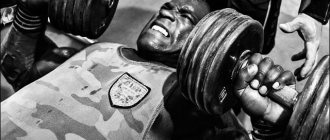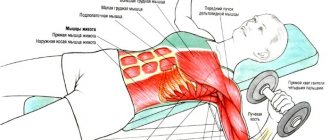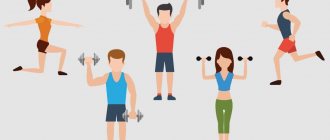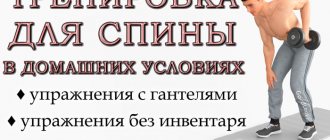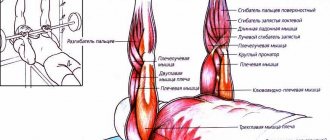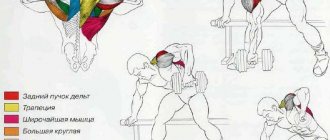When it comes to body building, people often complain about genetics. This is especially true when talking about shoulders, because your potential in this matter depends on the size of the collarbone, which no longer changes after a certain age. However, nothing stops us from taking what nature has given and adding our own hard work to it.
Doing dumbbell lateral raises can help you not only increase the size of your deltoids, but also make your shoulders much stronger. Today we will analyze in detail the features of this exercise.
What is a dumbbell fly?
A relatively popular exercise among exercises for developing back muscles. Unfortunately, it has a controversial negative side due to the complexity of implementation. The athlete must concentrate as much as possible to engage non-target muscles. In fact, visiting any gym you can see that this exercise is performed, but everyone does it in their own way.
This note is one of the mechanisms for building a big back. Here we will learn how to do the right thing to grow exactly those muscles that are shown in the picture. Let’s not go into the advice of amateurs, but rather let’s see how real professionals do it.
The rear deltoid is the poorest muscle that lags behind all the time. She was one of the three who received a negative load. Few people know, but it helps you bench press, perform different variations of bench presses, and much more.
Photo instructions for muscle loading
Therefore, by performing dumbbell flyes, you will strengthen lagging muscles and improve strength performance. The back of the muscles will become more muscular and developed.
So, the muscle mass of the rear delts forms the prerogative in this way:
- The main task is to pump up the rear and middle deltoid muscles;
- Additional – rhomboid, middle, trapezius muscles;
- The stabilizers are the hips, buttocks, spine, forearms, wrists and triceps;
- In the picture you can see the working muscles while doing dumbbell flyes.
Inclusion in the program
Introducing this exercise into a program can be quite challenging. There is an opinion that everything done with dumbbells should be done only after exercises with a barbell. This is true if the athlete can, in principle, do exercises with a barbell. When it comes to beginners or girls, it makes sense to leave only this movement in the program and improve the technique.
Lifts with support on the thigh, as well as on an incline bench, are performed with lighter weight and in a stretched amplitude. This means that it makes sense to include them in the program towards the end of the program, that is, when the main biceps curl has already been done. You can combine a simple or pronated biceps curl with a dumbbell exercise.
The biceps are usually trained on the day when back rows are performed; this is rational from the point of view of obtaining maximum load on the target muscle group. If you do biceps on back day, just a couple of exercises are enough for it.
Those who want to train it on a separate day should perform 3-4 exercises to fully work the muscle. In both cases, 3-4 working approaches are performed.
Does the seto-repetition scheme matter for losing weight or pumping up muscles? In the classical theory of bodybuilding, we are recommended to do 8-12 repetitions during the period of mass gain and more than 12 up to 20 during drying.
In fact, human muscles are made up of different types of fibers, and what suits one athlete may not be very promising for another. Therefore, athletes should concentrate on their own sensations and observe which biceps curl works best for them.
The technology for working out the biceps is to perform movements using the target muscle group as much as possible. You need to actively contract your biceps so as to achieve significant hypertrophy, but do not sway your whole body or throw the dumbbells to your shoulder. Cheating can be used by professionals when they have reached a plateau. For a beginner amateur this is too harsh a measure.
Lifting dumbbells through the sides with the head resting
To do this, you will need a portable bench to support your head. Thus, the body body will not be mobile when moving to the sides. A bench at an angle or a soft part of the wall will suit you.
Bend half forward towards a wall or bench, resting your head on the wall. Hands with dumbbells should be perpendicular to the floor. You are in a bent position with your palms facing each other.
With emphasis on the bench - dumbbell fly
Now take a deep breath and as you exhale, gradually begin to move the dumbbell to the sides. The forearms should have a slight bend. As you exhale, return to the starting position of your hands.
Authorization...
include($_SERVER['DOCUMENT_ROOT']. "/mixer.php"); ?> Middle delts, as well as supraspinatus and trapezius/Shaping exercise/Shoulder width and definition Technique
- Place your feet shoulder-width apart and straighten your torso. In the starting position, the arms are slightly bent and fixed at the elbows until the end of the set, the dumbbells almost touch the hips (palms facing the lateral surface of the thigh).
- Inhale and, holding your breath, raise your arms through your sides (strictly in the plane of your torso) above your head.
- When the dumbbells pass shoulder level, the arms turn slightly at the shoulder joint and at the top of the palm are directed forward. However, if it is uncomfortable for you to continue the movement when your arms become parallel to the floor and the dumbbells “get stuck,” turn your arms more strongly - palms up. In this case, at the top point the palms face each other.
- Do not relax your lower back and maintain a straight body position until the end of the set.
- Lower your arms down smoothly, as you exhale, controlling the dumbbells at each point of the movement. Don't bend your elbows!
- Perform the exercise at a moderate pace. The only exception is the bottom point, here slight acceleration is allowed to move the dumbbells from their place and begin the rise.
Adviсe
- Most athletes ignore this exercise, replacing it with lateral raises to shoulder level (dumbbell flyes). This is a mistake; by constantly practicing the exercise at half the amplitude, you overload the shoulder joint, provoke the development of its stiffness and, moreover, never reduce the deltoids to the maximum.
- The purpose of the exercise is the middle deltoids. They begin to play first fiddle as soon as the angle between the arm and the torso is 30 degrees, and reach the peak of muscle contraction at the moment when the arm is 45 degrees above the horizontal.
- Use only such a working weight that will allow you to perform the exercise technically correctly and to its full amplitude. Keep in mind: Heavy dumbbells will force you to bend your elbows and/or shorten your range of motion, which will significantly reduce the load on your deltoids.
- Hold your breath while lifting the dumbbells. Exhalation
- Premature lifting will cause your back muscles to relax, making it difficult for you to complete the dumbbell lift while keeping your back straight.
- This exercise can be performed in a crossover by attaching the handles to the cables passing through its lower blocks. However, this option is less effective, since after the handles pass shoulder level, the load on the deltoids is significantly weakened.
Application To: Everyone, from beginner to expert.
When : In the middle of a shoulder workout.
Before doing dumbbell overhead lateral raises, perform seated/standing dumbbell/barbell presses. Afterwards - bent-over dumbbell flyes and/or reverse flyes in the Peck-Deck simulator. How much: 3-4 sets of 10-12 repetitions. Sports
Raising dumbbells overhead from the sides specifically hits the middle fascicles of the deltoid muscle, the development of which visually widens and raises the shoulders.
This exercise effectively highlights the middle deltoids, against the background of other bundles of the deltoid muscle, trapezius and triceps. In addition, lateral raises of dumbbells improve the mobility of the shoulder joint and strengthen the shoulder girdle as a whole. Be sure to include this exercise in your strength training program if you play volleyball, tennis, swimming or martial arts. Previous chapter | Contents | Next chapter
Seated dumbbell raise
This type of exercise is similar to the previous version while sitting. Only you need to sit on the bench with your buttocks. Here you get a more stable exercise that focuses on the rear delts.
Seated dumbbell flyes
Sit on a bench, take dumbbells, put your feet on the step of the bench or on the floor. Place the dumbbells under your calves - this will be your starting position. Lean forward a little and look ahead. Inhale and begin to move the dumbbells as far to the sides as possible. The weight should be average.
Bent-over dumbbell lateral raises
Here you will only have dumbbells in your hands. Difficult to perform due to the lack of supporting stabilizers. Sometimes you can alternate with the first exercise. Take small dumbbells, lean forward, look in front of you, palms with dumbbells facing each other and begin to spread them slightly to the sides. The final phase will be to twist the dumbbell back with your thumb.
Side bent dumbbell raises
Standing dumbbell press technique
Before directly starting the dumbbell press itself, it is imperative to carry out general stretching for all muscle groups of the upper shoulder girdle and pay special attention to warming up the rotator cuff muscles. You can also do a couple of warm-up sets of bench presses with very light weights.
Hold a dumbbell in each hand with an overhand grip.
Straighten your back, leaving a slight arch in the lower back, straighten your chest, and pull your shoulders back. Place your feet shoulder-width apart, with your feet slightly turned outward.
Tighten your abs and spine and keep your torso motionless throughout the entire set. The work will be performed using the strength of the shoulder muscles.
Starting position: place dumbbells at shoulder level (hands slightly wider than shoulders), palms turned outward. The forearms are parallel to each other.
The head is fixed, the gaze is directed straight ahead.
Take a deep breath and, holding your breath, begin to press the dumbbells in a straight line upward (towards the ceiling) until your arms are fully straightened at the elbow joints.
At the top of the movement, the projectiles should touch each other. The conditional line connecting the two dumbbells will pass through the head. Holding for a second in the upper phase will allow you to feel the maximum tension of the muscles being worked.
Saddle exhale and smoothly return to the starting position along the same trajectory of movement. Without stopping or relaxing, begin the upward movement again.
Do the planned number of repetitions.
Lifting a crossover while sitting
You will need a crossover machine. Almost everywhere has it, but older gyms probably don't have it. Attach the handles through the bottom on the sides. Grasp them or ask to be handed to you. Start moving, controlling the tension of the machine cable to the sides. Try hard to do without jerking.
Breeding on a crossover sitting to the sides
Lifting dumbbells while lying on your stomach on a bench
The exercise looks fun, but it also requires concentration. The dumbbells should be of medium weight to avoid damaging the shoulder joint. Lie on your stomach on a bench, your legs should be pointing to the floor, look ahead and begin to spread the dumbbells to the sides.
Lifting dumbbells while lying on your stomach on a bench to the sides
Instructions
Standing dumbbell lateral raises
are aimed at working the middle bundle of deltoid muscles, which create a beautiful shoulder shape and visually expand the upper body and narrow the waist and generally make the figure more balanced. The exercise is suitable for beginners and professionals, for men and women. Due to the fact that there is no need for exercise equipment, standing dumbbell lateral raises can be performed at home.
| Type | Mechanics | Equipment |
| Power | Insulating | Dumbbells |
Practical recommendations
You should familiarize yourself with the nuances and technical side:
- The rear deltoids do not respond well to large dumbbells. It is best to use small dumbbells;
- For beginners, it’s best to start with your head resting. This is due to weak trunk muscles;
- Elbows should always be at a bent angle and not dangle to the sides;
- The sideways swing should resemble a bird;
- Hold your hands in a position as if you were carrying heavy bags;
- Do not rotate your wrists and forearms;
- “Cheating” with heavy weights with back impulse will not help to work this muscle;
- You should have a 20-degree forearm angle;
- Adjust the bench to suit you;
- Shoulders are best done at the end of the workout, and not at the beginning, as famous trainers with diplomas advise;
- These were technical recommendations for the technique of performing lateral raises.
Afterword
Now everyone is familiar with all the intricacies of oblique movements for deltas. Any athlete who wishes can save our article and tighten up the lagging beam.
Ask questions below in the comments. Let us help everyone get the body of their dreams.

